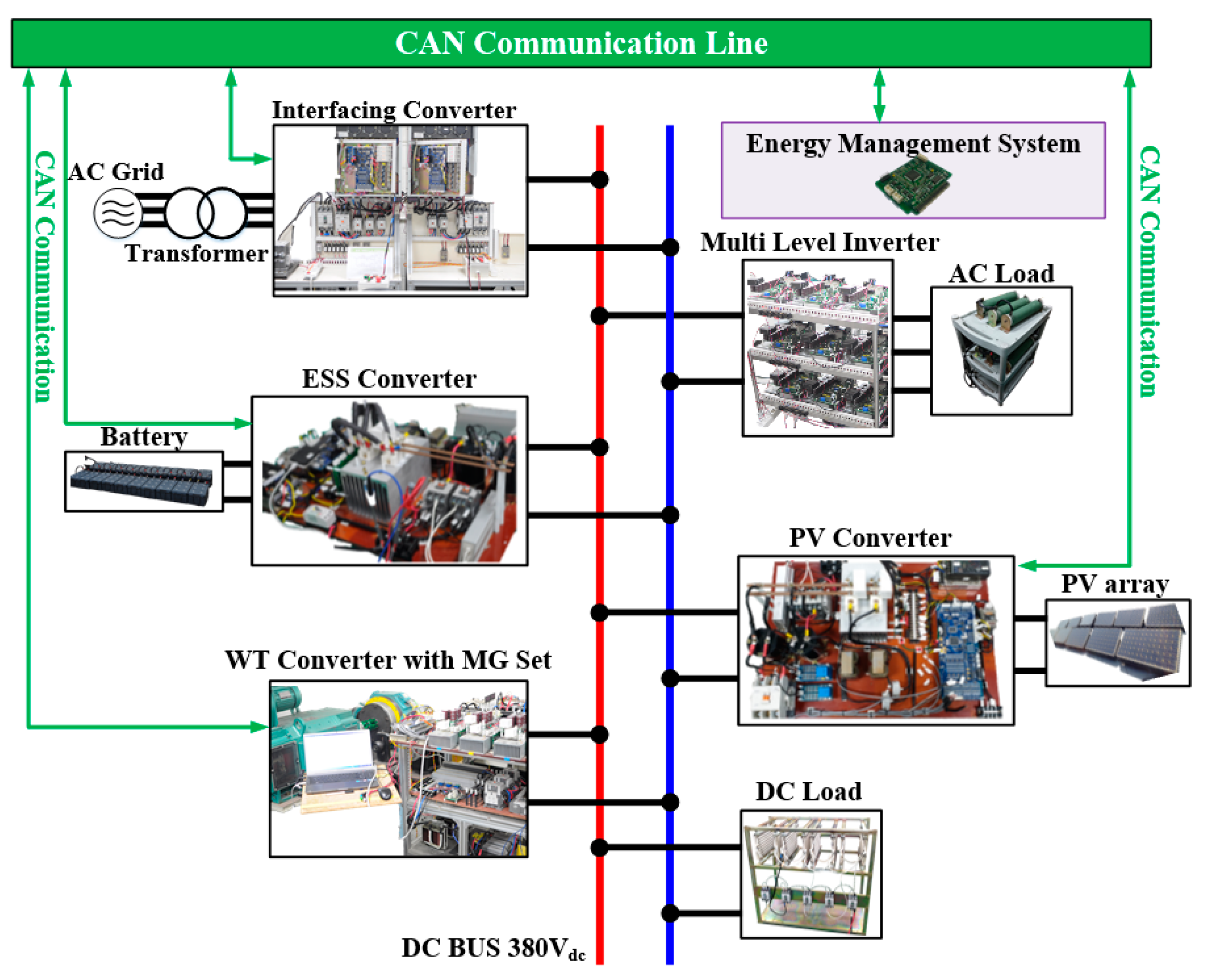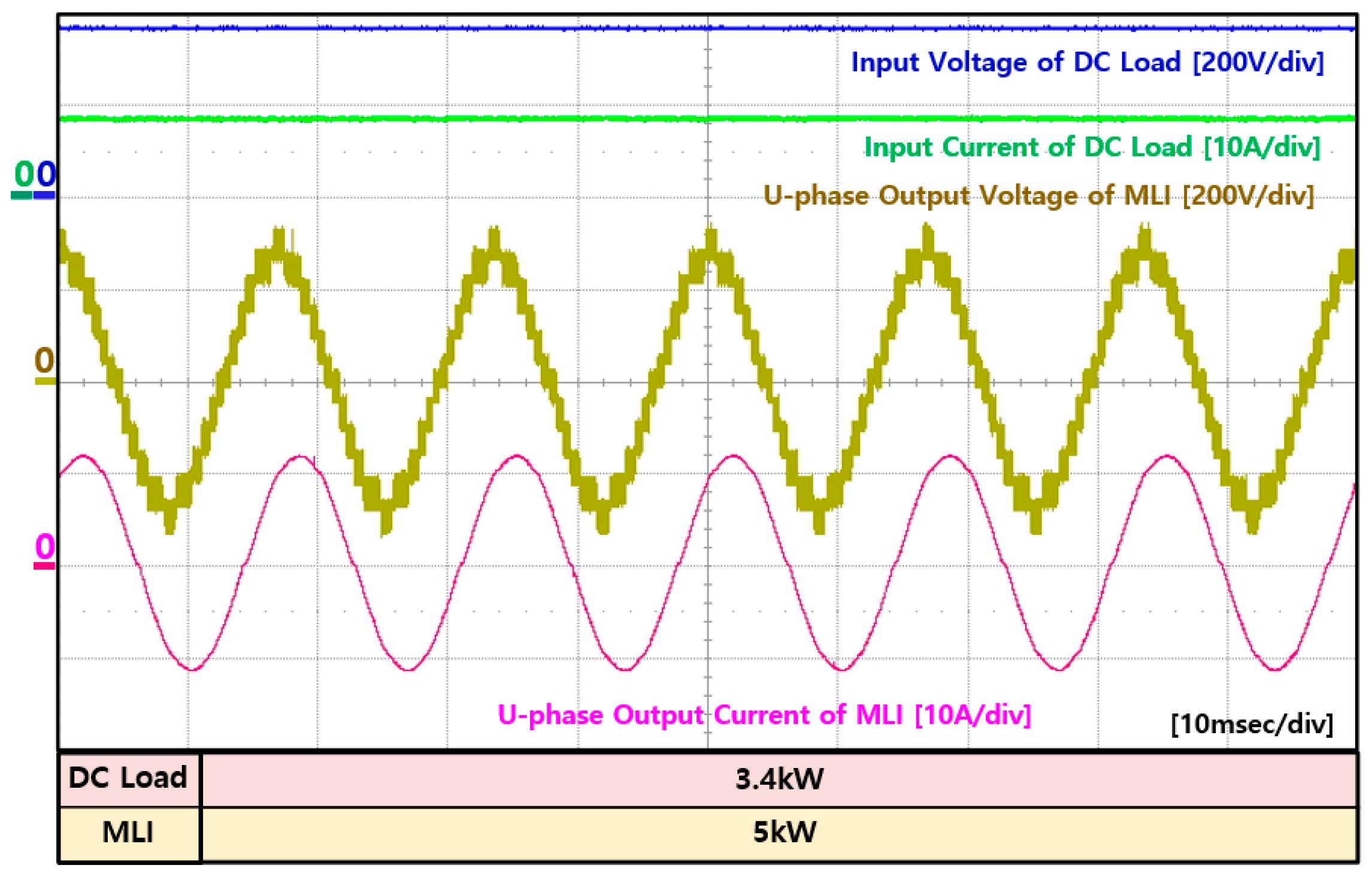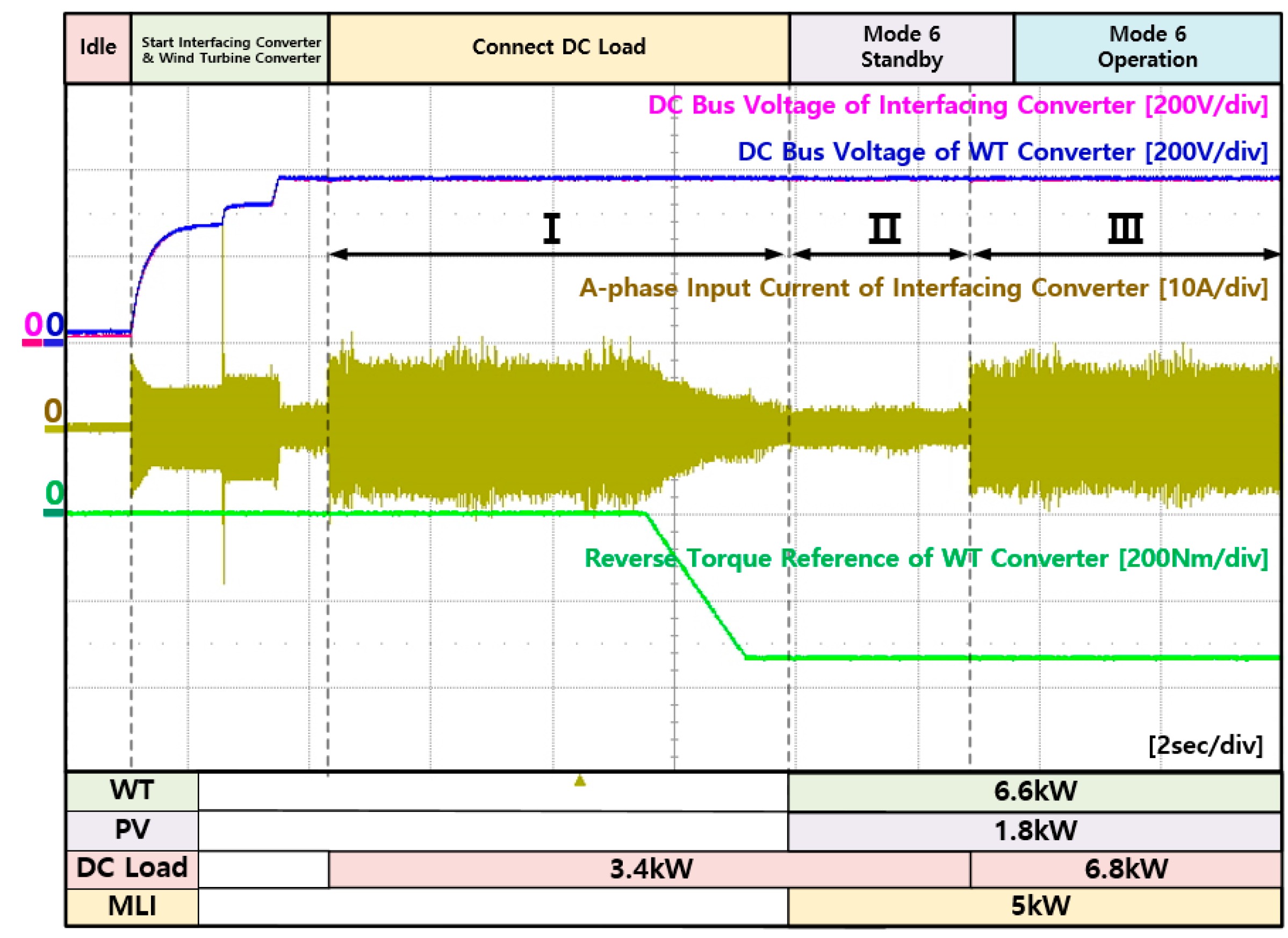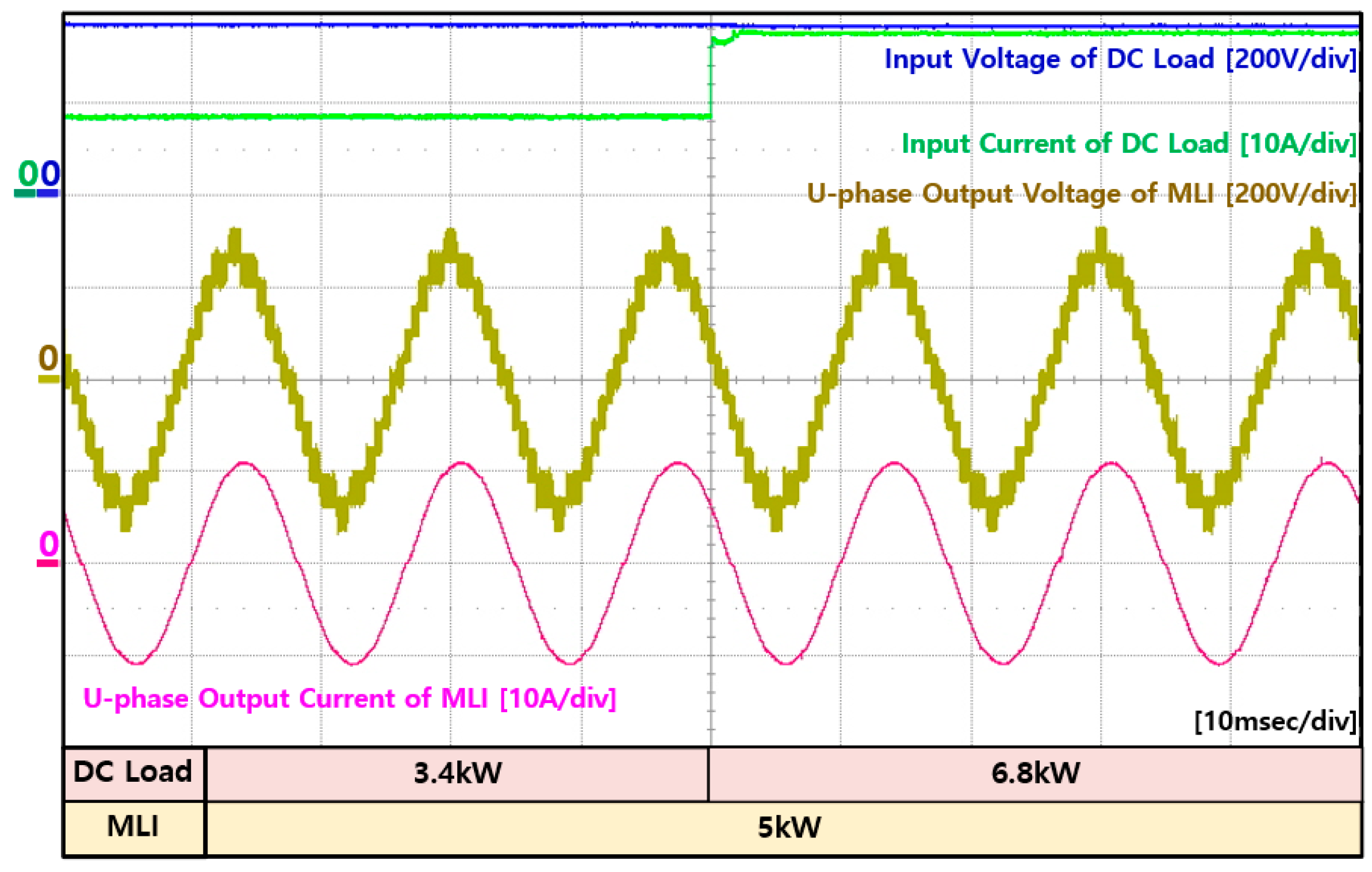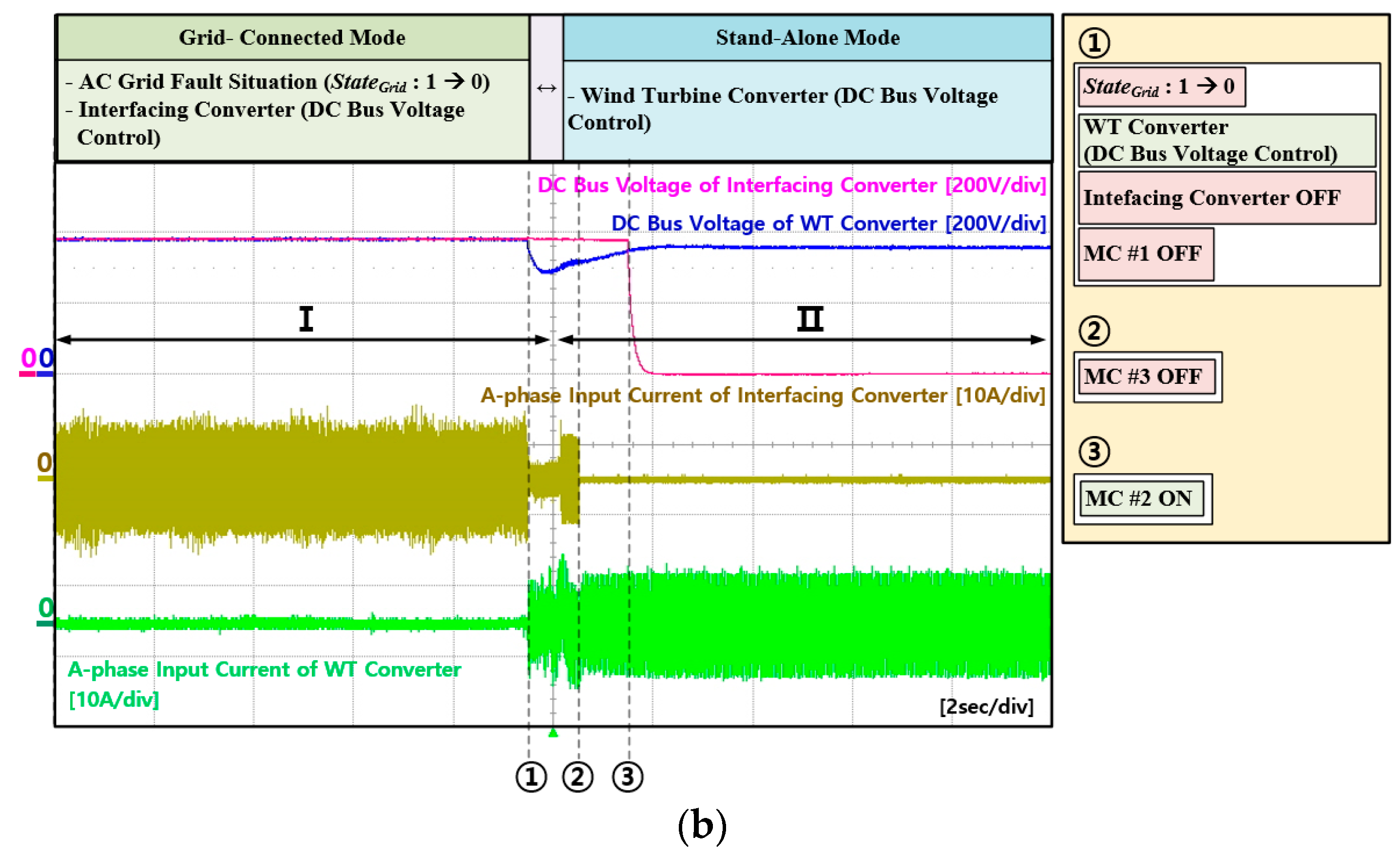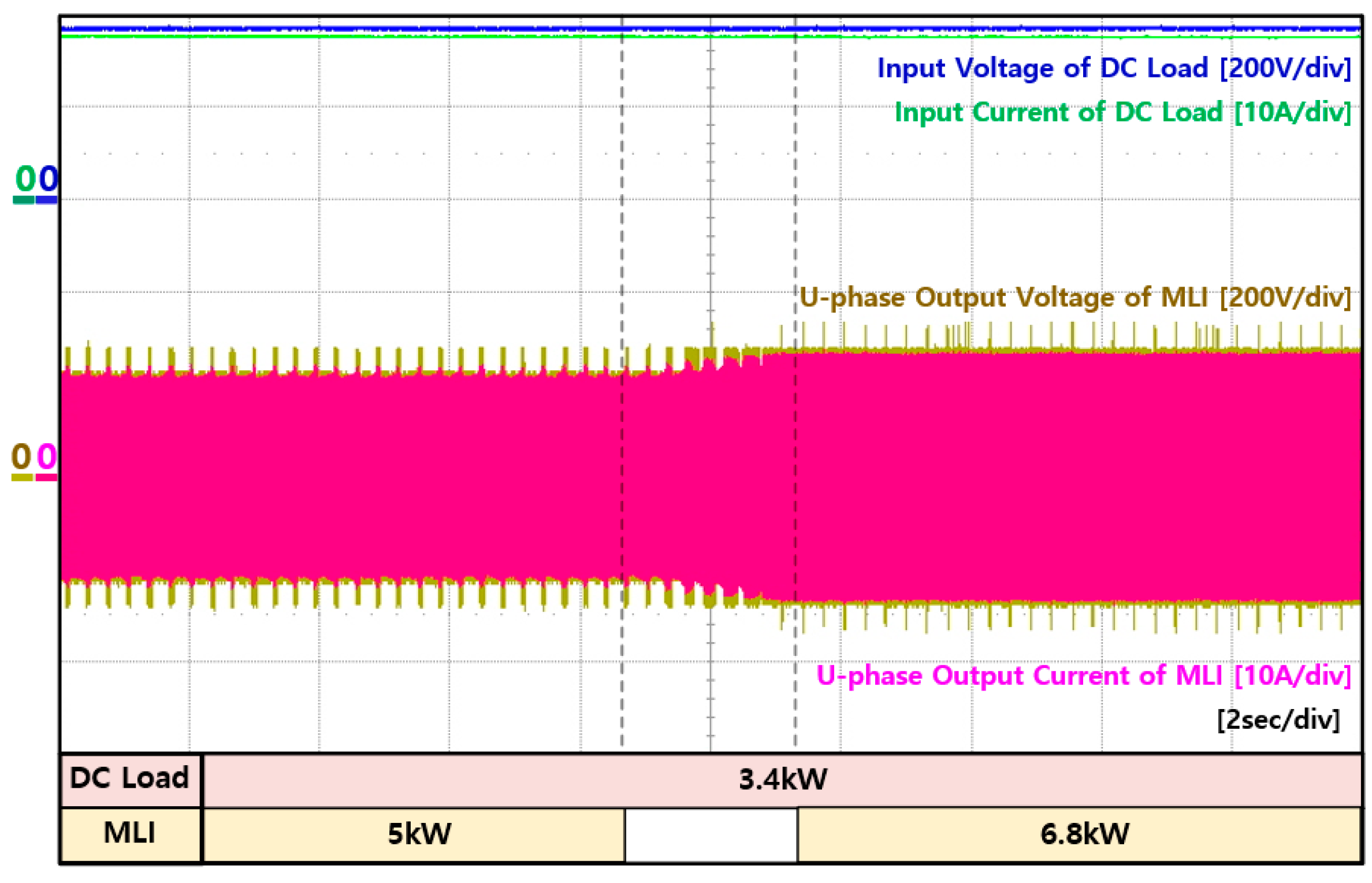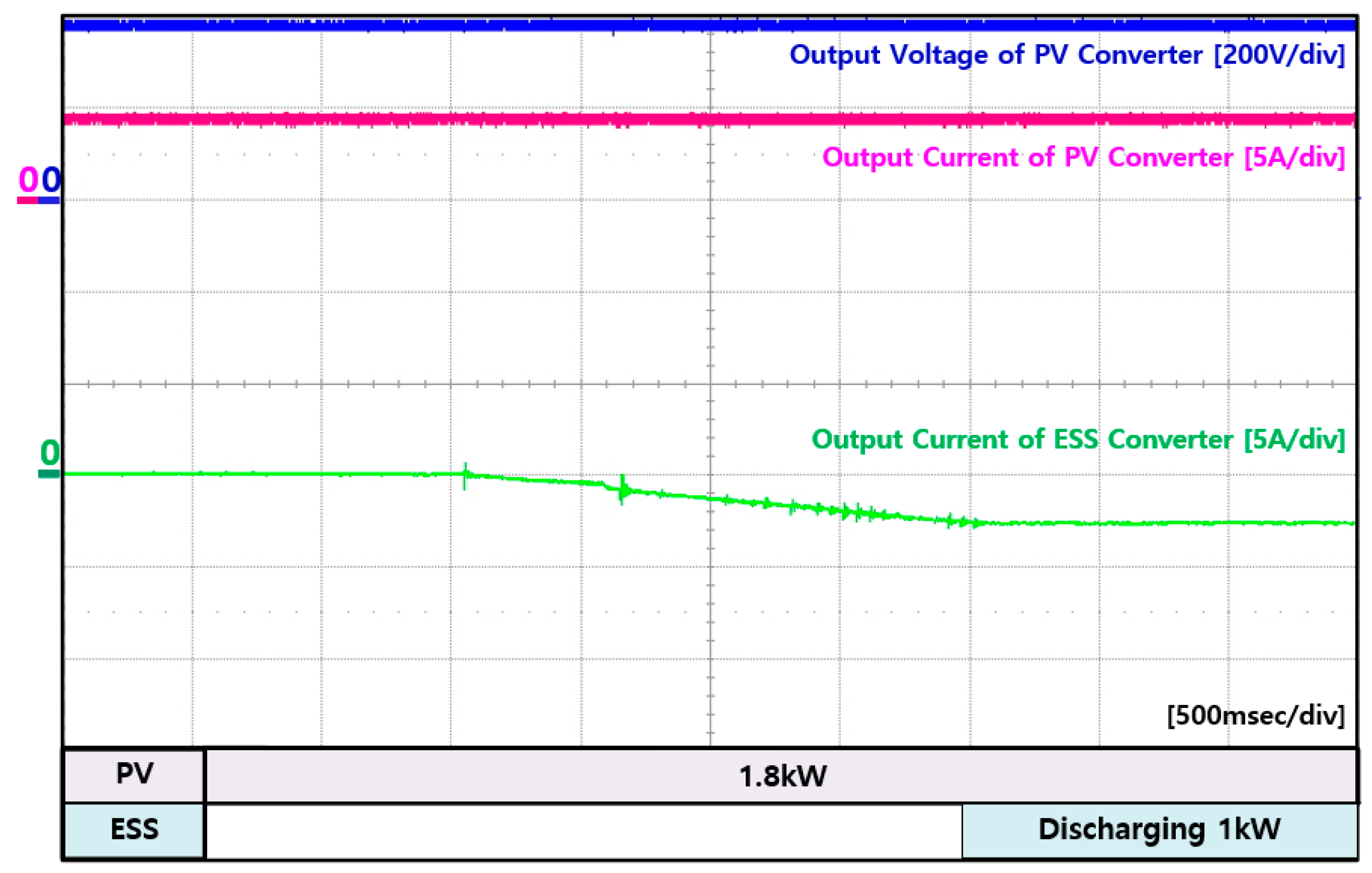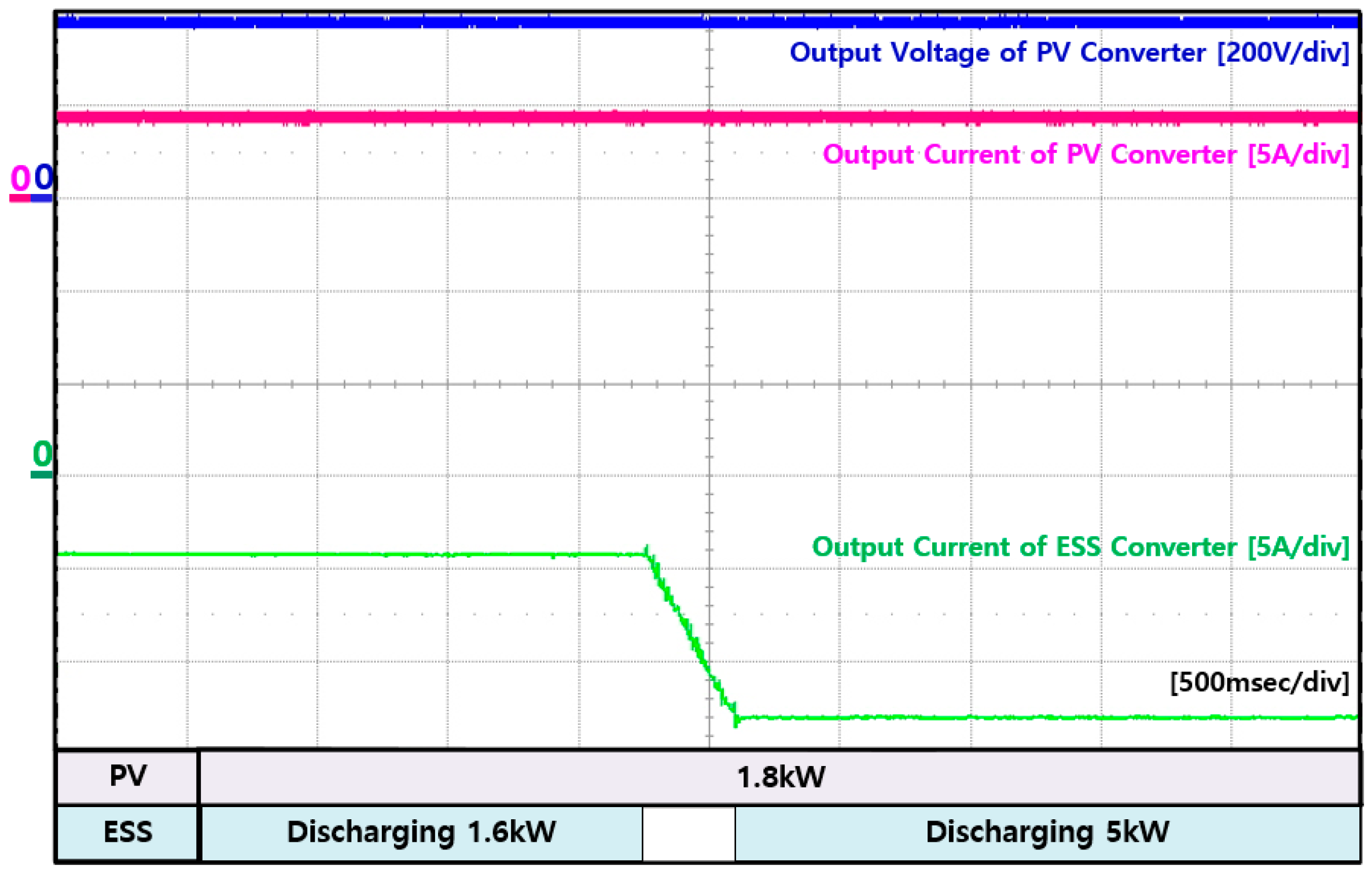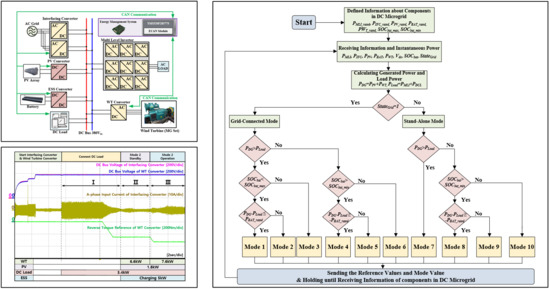Figure 1.
Control structure of DC microgrid (a) centralized control, (b) decentralized control.
Figure 1.
Control structure of DC microgrid (a) centralized control, (b) decentralized control.
Figure 2.
Configuration of DC microgrid with EMS.
Figure 2.
Configuration of DC microgrid with EMS.
Figure 3.
Control block diagram of power conversion devices with proposed EMS.
Figure 3.
Control block diagram of power conversion devices with proposed EMS.
Figure 4.
Flowchart of proposed EMS for operation method.
Figure 4.
Flowchart of proposed EMS for operation method.
Figure 5.
Flowchart of proposed EMS for operation method in grid-connected mode.
Figure 5.
Flowchart of proposed EMS for operation method in grid-connected mode.
Figure 6.
Flowchart of proposed EMS for operation method in stand-alone mode.
Figure 6.
Flowchart of proposed EMS for operation method in stand-alone mode.
Figure 7.
Experiment configuration of DC microgrid.
Figure 7.
Experiment configuration of DC microgrid.
Figure 8.
Experiment configuration of interfacing converter.
Figure 8.
Experiment configuration of interfacing converter.
Figure 9.
Experiment configuration of distributed energy resources (a) energy storage system, (b) wind turbine system.
Figure 9.
Experiment configuration of distributed energy resources (a) energy storage system, (b) wind turbine system.
Figure 10.
Experiment configuration of power conversion devices (a) PV converter, (b) MLI.
Figure 10.
Experiment configuration of power conversion devices (a) PV converter, (b) MLI.
Figure 11.
Experiment waveforms of interfacing converter and WT converter in mode 1.
Figure 11.
Experiment waveforms of interfacing converter and WT converter in mode 1.
Figure 12.
Experiment waveforms of DC load and multi-level inverter in mode 1.
Figure 12.
Experiment waveforms of DC load and multi-level inverter in mode 1.
Figure 13.
Experiment waveforms of PV converter and ESS converter in mode 1.
Figure 13.
Experiment waveforms of PV converter and ESS converter in mode 1.
Figure 14.
Experiment waveforms of interfacing converter and WT converter in mode 2.
Figure 14.
Experiment waveforms of interfacing converter and WT converter in mode 2.
Figure 15.
Experiment waveforms of interfacing converter at AC grid in mode 2.
Figure 15.
Experiment waveforms of interfacing converter at AC grid in mode 2.
Figure 16.
Experiment waveforms of DC load and multi-level inverter in mode 2.
Figure 16.
Experiment waveforms of DC load and multi-level inverter in mode 2.
Figure 17.
Experiment waveforms of PV converter and ESS converter in mode 2.
Figure 17.
Experiment waveforms of PV converter and ESS converter in mode 2.
Figure 18.
Experiment waveforms of interfacing converter and WT converter in mode 3.
Figure 18.
Experiment waveforms of interfacing converter and WT converter in mode 3.
Figure 19.
Experiment waveforms of interfacing converter at AC grid in mode 3.
Figure 19.
Experiment waveforms of interfacing converter at AC grid in mode 3.
Figure 20.
Experiment waveforms of DC load and multi-level inverter in mode 3.
Figure 20.
Experiment waveforms of DC load and multi-level inverter in mode 3.
Figure 21.
Experiment waveforms of PV converter and ESS converter in mode 3.
Figure 21.
Experiment waveforms of PV converter and ESS converter in mode 3.
Figure 22.
Experiment waveforms of interfacing converter and WT converter in mode 4.
Figure 22.
Experiment waveforms of interfacing converter and WT converter in mode 4.
Figure 23.
Experiment waveforms of interfacing converter at AC grid in mode 4.
Figure 23.
Experiment waveforms of interfacing converter at AC grid in mode 4.
Figure 24.
Experiment waveforms of DC load and multi-level inverter in mode 4.
Figure 24.
Experiment waveforms of DC load and multi-level inverter in mode 4.
Figure 25.
Experiment waveforms of PV converter and ESS converter in mode 4.
Figure 25.
Experiment waveforms of PV converter and ESS converter in mode 4.
Figure 26.
Experiment waveforms of interfacing converter and WT converter in mode 5.
Figure 26.
Experiment waveforms of interfacing converter and WT converter in mode 5.
Figure 27.
Experiment waveforms of interfacing converter at AC grid in mode 5.
Figure 27.
Experiment waveforms of interfacing converter at AC grid in mode 5.
Figure 28.
Experiment waveforms of DC load and multi-level inverter in mode 5.
Figure 28.
Experiment waveforms of DC load and multi-level inverter in mode 5.
Figure 29.
Experiment waveforms of PV converter and ESS converter in mode 5.
Figure 29.
Experiment waveforms of PV converter and ESS converter in mode 5.
Figure 30.
Experiment waveforms of interfacing converter and WT converter in mode 6.
Figure 30.
Experiment waveforms of interfacing converter and WT converter in mode 6.
Figure 31.
Experiment waveforms of interfacing converter at AC grid in mode 6.
Figure 31.
Experiment waveforms of interfacing converter at AC grid in mode 6.
Figure 32.
Experiment waveforms of DC load and multi-level inverter in mode 6.
Figure 32.
Experiment waveforms of DC load and multi-level inverter in mode 6.
Figure 33.
Experiment waveforms of PV converter and ESS converter in mode 6.
Figure 33.
Experiment waveforms of PV converter and ESS converter in mode 6.
Figure 34.
Experiment results of mode transition from grid-connected mode to stand-alone mode (a) configuration of experiment set-up, (b) waveforms of interfacing converter and WT converter.
Figure 34.
Experiment results of mode transition from grid-connected mode to stand-alone mode (a) configuration of experiment set-up, (b) waveforms of interfacing converter and WT converter.
Figure 35.
Experiment waveforms of DC load and multi-level inverter in mode 7.
Figure 35.
Experiment waveforms of DC load and multi-level inverter in mode 7.
Figure 36.
Experiment waveforms of PV converter and ESS converter in mode 7.
Figure 36.
Experiment waveforms of PV converter and ESS converter in mode 7.
Figure 37.
Experiment waveforms of DC load and multi-level inverter in mode 8.
Figure 37.
Experiment waveforms of DC load and multi-level inverter in mode 8.
Figure 38.
Experiment waveforms of PV converter and ESS converter in mode 8.
Figure 38.
Experiment waveforms of PV converter and ESS converter in mode 8.
Figure 39.
Experiment waveforms of PV converter and ESS converter in mode 9.
Figure 39.
Experiment waveforms of PV converter and ESS converter in mode 9.
Figure 40.
Experiment waveforms of DC load and multi-level inverter in mode 9.
Figure 40.
Experiment waveforms of DC load and multi-level inverter in mode 9.
Table 1.
Output power of each power conversion devices in mode 1.
Table 1.
Output power of each power conversion devices in mode 1.
| Components | Output Power [kW] | Components | Output Power [kW] |
|---|
| I | II | III | I | Ⅱ | III |
|---|
| Interfacing Converter | 3.4 | 0 | 0 | ESS Converter | 0 | 0 | 1 |
| PV Converter | 0 | 1.8 | 1.8 | Multi-Level Inverter | 0 | 5 | 5 |
| WT Converter | 0 | 6.6 | 7.6 | DC Load | 3.4 | 3.4 | 3.4 |
Table 2.
Output power of each power conversion devices in mode 2.
Table 2.
Output power of each power conversion devices in mode 2.
| Components | Output Power (kW) | Components | Output Power (kW) |
|---|
| I | II | III | I | II | III |
|---|
| Interfacing Converter | 3.4 | 0 | −1 | ESS Converter | 0 | 5 | 5 |
| PV Converter | 0 | 1.8 | 1.8 | Multi-Level Inverter | 0 | 0 | 0 |
| WT Converter | 0 | 6.6 | 7.6 | DC Load | 3.4 | 3.4 | 3.4 |
Table 3.
Output power of each power conversion devices in mode 3.
Table 3.
Output power of each power conversion devices in mode 3.
| Components | Output Power (kW) | Components | Output Power (kW) |
|---|
| I | II | III | I | II | III |
|---|
| Interfacing Converter | 3.4 | 0 | −2 | ESS Converter | 0 | 0 | 0 |
| PV Converter | 0 | 1.8 | 1.8 | Multi-Level Inverter | 0 | 5 | 5 |
| WT Converter | 0 | 6.6 | 8.6 | DC Load | 3.4 | 3.4 | 3.4 |
Table 4.
Output power of each power conversion devices in mode 4.
Table 4.
Output power of each power conversion devices in mode 4.
| Components | Output Power (kW) | Components | Output Power (kW) |
|---|
| I | II | III | I | II | III |
|---|
| Interfacing Converter | 3.4 | 0 | 0 | ESS Converter | 0 | 0 | −1 |
| PV Converter | 0 | 1.8 | 1.8 | Multi-Level Inverter | 0 | 5 | 5 |
| WT Converter | 0 | 6.6 | 5.6 | DC Load | 3.4 | 3.4 | 3.4 |
Table 5.
Output power of each power conversion devices in mode 5.
Table 5.
Output power of each power conversion devices in mode 5.
| Components | Output Power (kW) | Components | Output Power (kW) |
|---|
| I | II | III | IV | I | II | III | IV |
|---|
| Interfacing Converter | 0 | 0 | 2.3 | 2.3 | ESS Converter | 0 | −1 | −5 | −5 |
| PV Converter | 1.8 | 1.8 | 1.8 | 1.8 | Multi-Level Inverter | 5 | 5 | 5 | 7.3 |
| WT Converter | 6.6 | 5.6 | 1.6 | 1.6 | DC Load | 3.4 | 3.4 | 3.4 | 3.4 |
Table 6.
Output power of each power conversion devices in mode 6.
Table 6.
Output power of each power conversion devices in mode 6.
| Components | Output Power (kW) | Components | Output Power (kW) |
|---|
| I | II | III | I | II | III |
|---|
| Interfacing Converter | 3.4 | 0 | 3.4 | ESS Converter | 0 | 0 | 0 |
| PV Converter | 0 | 1.8 | 1.8 | Multi-Level Inverter | 0 | 5 | 5 |
| WT Converter | 0 | 6.6 | 6.6 | DC Load | 3.4 | 3.4 | 6.8 |
Table 7.
Output power of each power conversion devices in mode 7.
Table 7.
Output power of each power conversion devices in mode 7.
| Components | Output Power (kW) | Components | Output Power (kW) |
|---|
| I | II | I | II |
|---|
| Interfacing Converter | 10 | 0 | ESS Converter | 0 | 1 |
| PV Converter | 1.8 | 1.8 | Multi-Level Inverter | 5 | 4 |
| WT Converter | 0 | 10 | DC Load | 6.8 | 6.8 |
Table 8.
Output power of each power conversion devices in mode 8.
Table 8.
Output power of each power conversion devices in mode 8.
| Components | Output Power (kW) | Components | Output Power (kW) |
|---|
| I | II | I | II |
|---|
| Interfacing Converter | 10 | 0 | ESS Converter | 0 | −1 |
| PV Converter | 1.8 | 1.8 | Multi-Level Inverter | 5 | 6 |
| WT Converter | 0 | 10 | DC Load | 6.8 | 6.8 |
Table 9.
Output power of each power conversion devices in mode 9.
Table 9.
Output power of each power conversion devices in mode 9.
| Components | Output Power (kW) | Components | Output Power (kW) |
|---|
| I | II | I | II |
|---|
| Interfacing Converter | 10 | 0 | ESS Converter | −1.6 | −5 |
| PV Converter | 1.8 | 1.8 | Multi-Level Inverter | 0 | 0 |
| WT Converter | 0 | 10 | DC Load | 3.4 | 6.8 |







